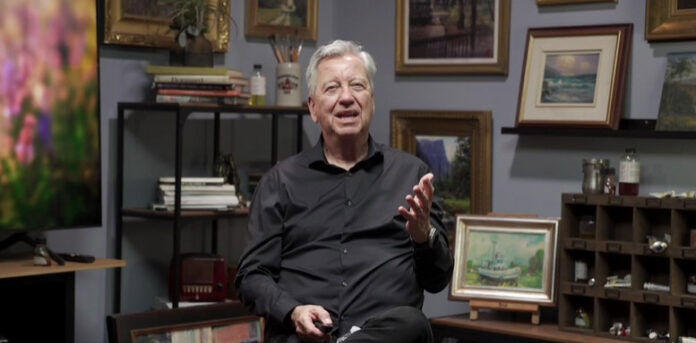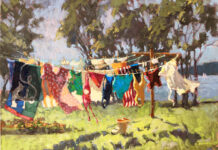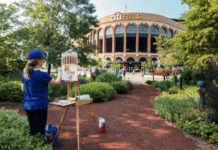Plein Air Painting for Beginners >
One of the benefits of attending the annual Plein Air Live virtual art conference is that it’s so full of tips, techniques, and even conversations about what it means to be a plein air painter. The following is from the “Every Plein Air Question Answered” session led by Eric Rhoads.
Stay tuned for more expert advice, and join us for the next events on the calendar > The Plein Air Convention & Expo (in person soon!) and Pastel Live (online!).
Q: Is it a Plein Air Painting if it was Touched up in the Studio?
By Eric Rhoads
I think the goal when painting outdoors, as far as I’m concerned, is to get one of two results. You either want a good study that you can use for making a painting later, or you want to have a good painting. In either case, there are no rules.
Now there are purists who say, look, a plein air painting has to be completed on location in one session. Some say you can do a painting on location, and go back to the same place over and over and over again if you want to. Any of those things are okay. If you want to go back to your studio and touch it up. That’s okay.
Now here’s what I do. I never touch a plein air painting because once in the studio I’m in a different environment, the vibe is different, I’m not outdoors and the light is different. If I start tweaking things based on a photograph, I tend to make my paintings too photographic in nature, I get too detailed, and I oftentimes mess them up.
So if I want to do a different painting, I’ll do a different painting from that plein air painting. And I might put more detail in it.
What are your thoughts? Share them with us in the comments section below!
And browse more free articles here at OutdoorPainter.com





I totally agree with your and your open minded well considered answer.
and for the record if I personally touch umps alien air painting it loses any of the magic it had.
Gary Smith
False Dilemma Alert: There are options between finishing on location and “touching up from a photograph.” And there is the risk that slight damage can be done in packing it out. Both repairing the damage and fixing small things you notice based on memory are, in my opinion, allowed. A huge percentage should be done on sight, but I don’t think you’re locked in when you close the backpack. But I would not use photographs, only notes and sketches made prior to or during painting.
As for the other part, Monet REGULARLY painted plein air work in multiple settings. He was famous for a cart of canvases that he would haul out each day and work on each one in order for about 10 minutes and then change canvas as the light changed. I don’t think anyone would call these NOT plein air.
Finally, I know a lot of artists that sign their paintings later. That’s not an issue either.
I totally agree with Marc. I used to be quite fanatical that a plein air painting was a snapshot of 2 or 3 hours in a particular location on a particular day. If I did any touch ups later, it was to clean up schumtz from transporting the painting or adding my signature. Over time, I’ve come to realize that when you’re painting a landscape (or a still life, a figure, or anything), for the first third of the time, you’re observing, measuring, laying out the composition, and rendering what’s in front of you. By the final third of the time, you’re glancing up at the subject only occasionally because the painting has advanced enough that it begins dictating what it needs more than the subject does. Recently I’ve come to the conclusion that there’s no reason to take this a step further and continue to work on it in the studio if that’s what the painting needs to pop. And I do agree with Gary that doing this from a photograph tends to produce a painting of a photograph rather than of a living scene. Besides, I find that any photo I’m likely to take on-site is going to lack the information I really need to complete the painting. Or it will be distorted. If I’m already two or three hours into a painting, what I need to finish it off will be in my memory.
Plein Air means painted in the open air , right !? ONCE ITS TOUCHED IN THE STUDIO , I feel it gets “non -plein -aired, ha ! ”
I am a studio painter …but when I do En Plein air , I never touch it in studio because of lighting . Why would I ? It would diminish that “magic” from painting it outside .
My two cents 🙂
Warmest Regards,
Debb Ferris Bates
New Brunswick,
CANADA EH !
I agree with Robert and Marc with their points. To Eric, the ideal IS to finish your work during your Plein air session, and transport it with no unhappy accidents back to dry in your studio. Signature timing seems a moot point to me. You might etch it in as I do, or paint it in when it is in the studio. I’ve never felt I’ve NOT painted my work Plein air when almost all of it was completed before it reached home. A few minutes of quick correction when the ambience and memory of the day is still fresh does not lessen its description IMHO.
I don’t mess with them after I bring them home as I feel like the excitement and spontaneity of the moment is past. And I sign them while on location.
Tammy Delaney
Gold Beach, Oregon
I’ve often sold my painting directly from my easel to someone passing by to watch the process. There was no opportunity to take it home for a touch-up. I do, however, prefer to view the painting in my studio for several days (oe longer) to eventually tweak or make artistic adjustments to improve the overall painting prior to framing.
Nonsense, this is your painting, your point of view. You are creating your viewpoint, there are no rules to keep you in sync with other people if it’s your own work . Nobody from the history of painting did everything in the outdoors. They all either ‘touched up ‘ in studio or even in the gallery as JMW Turner did on occasion.
My really excellent Plein air experiences produce work I finish in one sitting and I love them so much I don’t change a thing. But there are other times, when things don’t go perfectly , maybe I was hungry, perhaps the weather changed , I may tweak those ( and by tweak I mean 10-5% ). Here’s my handy tip , take a video instead of a photo , I watch the video and it’s a much better reference!
Good idea. Neither photo nor video are good for color reference…but seeing some of the linear info and for correcting placement they are helpful. I do multiple trips to do as much on site as possible but there are few pieces I manage to finish on site. I find working just photos boring and uninspiring but breathing the air and being there is what gives me the lift to create.
When I take trips I program in days for doing pastels (since the cost of transporting my acrylic stuff would be prohibitive.) You can’t go back day after day for that.
I totally agree with you Eric. Other wise why call it “plein air”?
If I’m not completely pleased with a painting I did en plein air I see no reason not to give a few touchups in the studio. I prefer to do those touchups from memory instead of from a photo because ultimately it’s my creation and interpretation of the scene and not a photographic recreation.
One workaround to the problem of being in a different environment in the studio, is when you get a good start down, you can take a picture of your painting on your iPad and paint over it digitally as much as you want, and then you will have an authentic reference from your own experience rather than a photograph, to finish from. Getting the weather to match up on different days is pretty rare.
when we were in grade school and learning to spell weren’t we required to correct the mistakes and then hand them in. Exercising the editing skills on a plein air pc. can be a very valuable learning experience.
I paint plein air weekly here in Hawaii. We have a critique with our art group at the end of our 3 plus hour painting sessions. Someone almost always makes a valid comment about improving the work and I take it home and do the touch up needed. It becomes a better painting in the end and it rarely takes longer than a few minutes to “fix” the glitch. I still call this plein air as 90% or more is done on site. We all love the insights of the group to help us make better paintings.
If I finish a plein air painting in the studio and sell it, I am careful not to represent it to my client as a plein air painting, and if I am participating in a plein air event where there is judging and/or sales involved, I do not touch it in the studio. Honesty and integrity are much more valuable than money and awards.
What a different set of comments from a year or so ago~! THAT all the artists here, agree: “plein air” is JUST that > done on location ~ Period. Even my larger mural size paintings (48″ high x 5 or 6 feet) were captured “on location”. If any “touch up is done” it should not be more than “tweaking” it here or there, moments NOT hours of “touch up”, more than a few moments, it is a studio creation It truly is wonderful to see this sort of “integrity” TODAY, dealing with the word “plein air”!
I recently returned from a 26 day trip across country with my husband and service dog. I, of course, brought my plein air kit and a large stack of panels. The deal we made was that we would not drive long distances on the interstates (which he wanted to do), and to pay him back for this we would only stop at designated pullovers and I would limit my painting time to an hour at each stop. I did get a couple of 2 hour paintings in because other tourists stopped to talk and he wasn’t going to burst in and tell me my time was up. So, as a result I got a lot of color studies done and came home with over 1000 photos to pair them up. I also got several dozen quick sketches done. Would I have preferred more time to paint? Absolutely, but we would have been on the road for another month if I had. As it was, we had a wonderful trip, visited many places neither of us had previously seen and being off the highways were able to really appreciate the small towns, the back roads and the less developed areas still out there between the Virginia Coast and the Oregon and California Coasts. We are already planning our next trip in the Fall of 2024 when we are going to cross through (or at least touch) as many Southern states as we can. I’m also making a list of places to which I want to return just for a week or two of painting.
Painting Plein air , the light changes every minute so sometimes you can not complete the painting. Rain , storm clouds etc change the light so sometimes you have to complete the painting back in your studio. It is OK. TAKE A PHOTO AS SOON AS YOU GET READY TO PAINT. Then you have the reference if you need it ! Be assured Matisse, Van Gough, Monet touched up in the studio. GO PLEIN AIR PAINTERS !
I work on large paintings – 2 feet by 3 feet, if not larger. I find a location I want to paint, and I haul everything out of my car and set up and paint. I’ll be there anywhere from 45 minutes to an hour and a half. I just finished a 2 ft. by 4 ft. today. I sketched it out and started the painting from the left. I coded color for the sky and painted that in as a base color back at the studio. By the way, my studio is the laundry room, so the less time I spend working there, the better. In this painting, all large sections were covered with a base color, and then the details and textures were painted on location. I started this painting in early June, so it’s taken a month to paint it. During that time, we experienced (and are still experiencing a drought. Much of the foreground was changed from greens to yellows and browns in order to achieve consistency. I do have to adjust the perspective on a some of the fence posts a bit, and that will be done in the washing studio. I spend way too much time outside painting to worry about things like details.
I feel very cramped doing small pictures, so my work involves repeated visits to a location, and sometimes talking with any people who come by. No, I don’t get offers to sell my work. They’re big. But i do get a nice tan from all my visits. I’m hoping I can get ten pieces done this summer but we do need rain. Thanks for letting me put in my two cents work.
You’re right. There are no rules. Just what is right for each individual if you are trying to get the best painting or study that you can from the situation…
BUT… if you are in a plein air competition, or entering a plein air only show, there has to be rules just like in any other competitive situation.
This article in Outdoor Painter may be of some interest:
https://www.outdoorpainter.com/plein-air-painting-and-studio-enhancements/